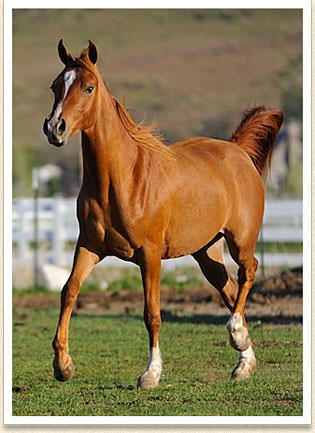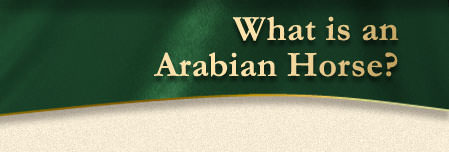
What is an Arabian Horse?
from "Flight Without Wings" by Patti Schofler
Dating back 3500 years, the Arabian is the oldest, the purest, and the first man-manipulated (selectively bred) breed. Perhaps no other breed has been so engaged in the romance and history of the world. He has made his presence loudly heard not just in the Middle and Near East, in Egypt and North Africa, but also in England, Poland, Spain, Hungary, Russia and the United States. Both in his pure state and as a contributor to the improvement of some breeds and the creation of others. Today virtually every light horse (ridden) breed, from Appaloosa to Welsh, has Arabian blood coursing through its veins.
The Arabian horse is within himself a mesh of contrasting characteristics that make an ideal show horse. He is at once a lively, fiery spirit, proud and regal in his carriage, his presence and charisma, and yet also a gentle, docile soul. His intelligence, willingness to please, and comfort with the human species allow him to, on command, exude tremendous vitality, and yet at another moment, to welcome a child to safely lead and ride him. A fairy tale horse, he is bred for his exquisite beauty, quality and refinement, and yet his genes are coveted for their link to soundness, stamina and endurance. He is rock-hard tough in spirit, flesh, bone and ligament.
What is a Spanish Arabian Horse?
from Wind Dancer Ranch
Classical Spanish Arabians are purebred Arabian horses that are descended in all four lines of their pedigree from horses registered with the Spanish Stud Book (SSB) prior to 1970. Much ‘outcrossing’ was done in Spain in the 70s and 80s. That has resulted in some good horses, and of course some not so good, depending on the animals (and their quality) used in the cross.
One reason we treasure the Classical Spanish Arabian (in the SSB prior to 1970) is for their prepotence as breeding animals. We can count on them. These horses are the product of 200 years of careful selection, breeding and culling from the Yeguada Militar (YM), a government agency under the Minister of War that directs all horse breeding in Spain.
The original bloodstock of the YM was selected from some of the finest Arabian horses available in Arabia, Egypt, England, Poland and France. Since their mission was to create cavalry mounts, they chose horses with amazing athletic ability, soundness, stamina, and a trainable mind. The horses had to work well with their riders, the lives of both animals and people depended on it.
Spanish Arabians tend to be more robust, with more substantial bone then other bloodline groups, and yet they retain a classical elegance in look and demeanor. It is one big reason they seem to "stand out" in the show ring. This has enabled a very small group (1/10 of 1% of Arabians in the USA are Classical Spanish) of Arabians to win a lion’s share of the prizes time after time. Their wonderful work ethic is certainly a part of their winning ways as well.
They excel at the “Sport Horse” disciplines, Dressage, Hunters, Jumpers, Driving, Cross Country, Sport Horse in-hand, Sport Horse under Saddle, and Sport Horse Show Hack. At present there are 88 Sport Horse classes in the Sport Horse Nationals. In fact, we owe the growing popularity of the Sport Horse classes and Sport Horse Nationals (SHN) to the organizational efforts of the Stanley Ranch and the winning ways of their Spanish Arabians. EXODUS I +//, a Classical Spanish stallion owned by Stanley Ranch, was the Highest Scoring purebred Arabian at the inaugural show in 2003, ridden by their daughter Lisa in Working Hunter over fences and under saddle (stats from AH World). The Highest Scoring Half-Arabian was in fact half Classical Spanish. There were less than 5 Classical Spanish Arabians shown at that National Show.
2013 will be the eleventh year for the SHN, which rotates from East Coast to West Coast. 2013 dates: September 18 – 22, Lexington Horse Park, Lexington Virginia.
In 2014, SHN will be held the third week of September at the Idaho Horse Park, Boise, Idaho.
I fell for Spanish Arabians because of their solid, smooth bodies and excellent temperaments (oh, did we mention their oh-so-smooth gaits?). All my Arabians have been very calm, friendly, trusting and affectionate, and I wanted my breeding program to continue in that way. I found the Spanish Arabians already had a preponderance of my "necessary list" for my breeding program. It is due in great part to the rigid culling practices of the Yeguada Militar over the last 200 or so years. While there are exceptions, I find the Spanish Arabian to be as follows:
- More substantial – meaning wider, deeper, with more bone
- Three circle round horses
- Powerful and well-muscled in the rear
- Excellent movers with smooth, ground-covering gaits
- Balanced
The other wonderful thing about Spanish Arabians is the experienced and friendly group of Spanish Arabian breeders who dedicate themselves to preserving these great bloodlines. They are helpful, informative and friendly. Even the most famous of them won’t hesitate a second to help out a beginner. They are a model to the horse community as a whole regardless of breed. If you want to learn about good Arabian horses, a great place to start is here, with Spanish Arabians.


